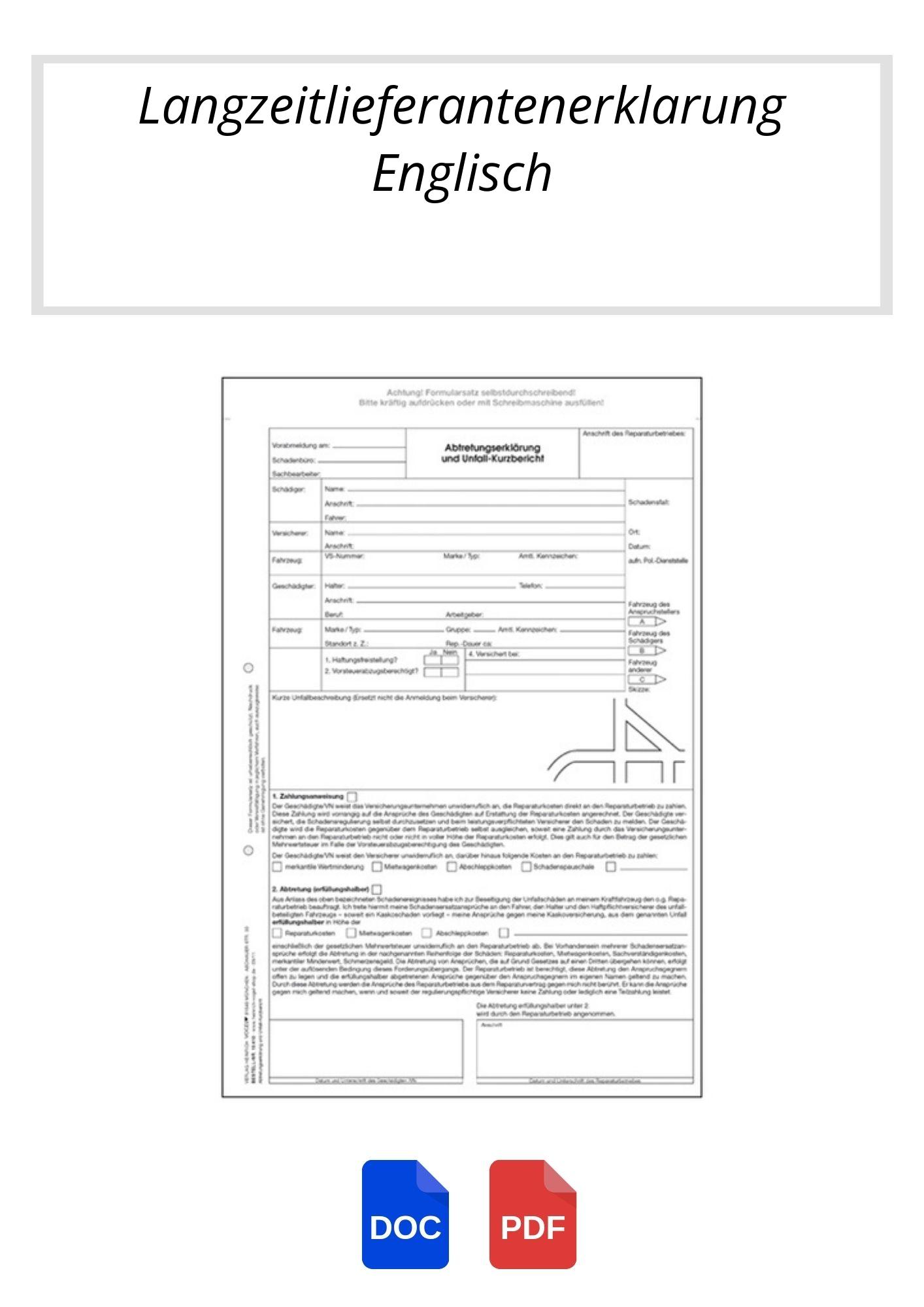Muster und Vorlage für Langzeitlieferantenerklärung Englisch zur Erstellung und Anpassung – Öffnen im WORD– und PDF-Format

| PDF – WORD Datei |
| ⭐⭐⭐⭐⭐ 4.42 |
| Ergebnisse – 1245 |
| Autor – Levin Albrecht |
| Prüfer – Kasimir Eichhorn |
Example of Long-term Supplier Declaration in English
A Long-term Supplier Declaration is a document that certifies the origin of goods in an international trade transaction. This declaration is issued by the supplier and must be submitted to the customs authorities of the importing country. It serves to prove that the goods meet the requirements of preferential treatment under a free trade agreement or other trade arrangements.
Parts of a Long-term Supplier Declaration:
- Supplier Information: This section should include the full name and address of the supplier, as well as any other relevant contact information.
- Buyer Information: The full name and address of the buyer should be included, along with any other necessary details.
- Goods Description: A detailed description of the goods being supplied, including the HS code, quantity, and value.
- Country of Origin: The country where the goods were manufactured or produced must be clearly stated.
- Declaration and Signature: The declaration should state that the goods meet the origin requirements of the relevant trade agreement. The signature of the supplier is also required.
Format of a Long-term Supplier Declaration:
The Long-term Supplier Declaration should be printed on company letterhead and signed by an authorized representative of the supplier. It should be issued in English, as well as any other required languages depending on the importing country’s regulations. The document should be dated and include a unique reference number for tracking purposes.
Overall, a Long-term Supplier Declaration is a crucial document in international trade, as it ensures compliance with the rules of origin and facilitates the customs clearance process. Both suppliers and buyers should understand the requirements of these declarations to avoid any delays or issues with their shipments.
- 1. What is a Long-Term Supplier Declaration (LTSD) in English?
- A Long-Term Supplier Declaration (LTSD) is a document provided by a supplier to a customer to declare the origin of goods being supplied. It is used in international trade to prove the preferential origin of goods, allowing them to benefit from reduced or zero tariffs under certain trade agreements.
- 2. When is a LTSD required by a customer?
- A LTSD is typically required by a customer when they are importing goods that are eligible for preferential treatment under a trade agreement. The customer needs the LTSD to claim preferential tariffs or other benefits when clearing customs.
- 3. What information should be included in a LTSD?
- The information that should be included in a LTSD typically includes details about the supplier, the customer, the goods being supplied, the country of origin of the goods, and a declaration by the supplier that the goods meet the origin requirements of the relevant trade agreement.
- 4. How often should a LTSD be updated?
- A LTSD should be updated whenever there is a change in the information contained in the declaration. This could include a change in the supplier’s details, the goods being supplied, or any other relevant information that may affect the origin of the goods.
- 5. Are there any specific formats or templates for a LTSD in English?
- While there are no strict rules on the format or template for a LTSD, it is recommended to follow a standardized format that includes all the necessary information required by the relevant trade agreement. Some trade agreements may provide specific templates or guidelines for LTSDs.
- 6. How should a LTSD be signed and submitted to the customer?
- It is important that a LTSD is signed by an authorized representative of the supplier’s company. The signature should be accompanied by the date of signing to indicate the validity of the declaration. Once signed, the LTSD can be submitted to the customer through various means such as email, fax, or uploaded onto a secure online platform as per the customer’s preference.
- 7. What are the consequences of providing inaccurate information in a LTSD?
- Providing inaccurate information in a LTSD can have serious consequences for the supplier. It can lead to legal implications, financial penalties, loss of credibility with customers, and potentially damage the reputation of the supplier’s company. It is crucial for suppliers to ensure the accuracy of the information provided in a LTSD to maintain trust and compliance with customers.
- 8. Can a LTSD be used for multiple customers or orders?
- Yes, a LTSD can be used for multiple customers or orders as long as the information included in the declaration remains relevant and accurate for each customer or order. Suppliers must ensure that the information provided in the LTSD aligns with the requirements of each customer to whom it is being submitted.
- 9. Are there any specific requirements for a LTSD for certain industries or products?
- Yes, certain industries or products may have specific requirements for a LTSD based on regulatory standards, trade agreements, or customer preferences. Suppliers should familiarize themselves with the specific requirements of the industries or products they are supplying to ensure compliance and accuracy in the LTSD.
- 10. What is the difference between a LTSD and a Certificate of Origin?
- A LTSD and a Certificate of Origin serve different purposes. While a LTSD declares the origin of goods and compliance with certain regulations or requirements, a Certificate of Origin specifically certifies the origin of goods and is often required for customs clearance, trade agreements, or import/export documentation. Both documents play a vital role in international trade, but their focus and use differ.
- 11. What is the difference between a LTSD and a Certificate of Origin?
- While both documents provide information about the origin of goods, a Long-Term Supplier Declaration (LTSD) focuses specifically on the origin of components or materials used in the production of goods over an extended period of time. On the other hand, a Certificate of Origin certifies the origin of an entire product and is usually required for customs clearance purposes.
- 12. How should a supplier verify the accuracy of the information provided in a LTSD?
- Suppliers should have robust procedures in place to verify the accuracy of the information provided in a LTSD. This may include maintaining detailed records of suppliers, conducting regular audits and inspections, and requesting supporting documentation from suppliers to confirm the origin of components or materials.
- 13. Can a LTSD be submitted electronically or does it need to be in hard copy?
- Most customers accept electronically submitted LTSDs, but it is important to check the specific requirements of each customer. Electronic submission can streamline the process and ensure timely delivery of the declaration to the customer.
- 14. How long should a supplier retain copies of LTSDs for audit purposes?
- Suppliers should retain copies of LTSDs for a minimum period of 5 years, as this is typically the timeframe for audits and inspections by customs authorities. It is important to keep these documents organized and easily accessible in case of any inquiries or audits.
- 15. What is the role of a customs broker or agent in relation to LTSDs?
- A customs broker or agent can provide valuable expertise and assistance in navigating the complex requirements related to LTSDs. They can help ensure that the LTSDs are compliant with customs regulations, assist with the submission process, and handle any issues that may arise during customs clearance.
